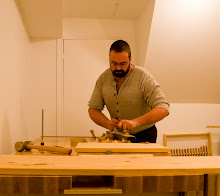
A story pole is a narrow piece of material with crucial measurements marked on it in 1:1 scale. You use it as a big ruler. Instead of using a tape measure to measure parts, which involves remembering the dimensions and is a process prone to error, you use the marks on the story pole to directly. No measuring, just comparison. As you can see from looking at the picture of the story-stick on the right you can see the physical construction of the piece in vertical cross-section. If the story-pole is held against a partially complete piece of casework you will be able to verify that the assembly is accurate. Any inaccuracy will be painfully obvious, as will be shown when there is casework to compare to the story pole. You use a rule to produce the story-pole, but inaccuracies in the design show up on the pole.
The design for this bedside dresser was begun with the rough sketch shown in the previous entry, and the design is continued on the story pole. I started by finding a suitable piece of wood. I needed one that was longer than 27", because I had decided on that dimension for the height of the piece. I drew the applied top of the piece on the story pole, then marked 27" below that and drew a baseline. I fleshed out the applied top piece, 3/4" thick (because that's the thickness of the stock that I have) and added the bevel detail. I then drew in the side, though the side 'peters out' near the bottom because the length of it isn't critical because the base overlaps it. I drew the top of the carcase (which is immediately below the applied top) and drew the base. I had decided on 4" tall as the appropriate height of the base, and I wanted the bottom of the carcase to be overlapped a bit to make sure there wouldn't be any cracks showing. This gave me a set location for the top and bottom of the carcase. I grabbed the rule and checked and found that I had 21" between top and bottom. I thought maybe 7" might be okay for the bottom drawer and drew that in, but I didn't like it so I erased that and moved it to 7-1/2". A bit of trial and error got me drawers that are, bottom to top, 7-1/2", 6-1/2", and 5-1/2". These are deep-ish drawers, but I want them to be suitable for clothing, so deep isn't a bad thing, particularly when some depth will be lost to the drawer bottom.
So now the story stick is done in the vertical dimension, and the next step is to flip it over and draw the piece showing the horizontal sizes. Needed will be the top, and indication of the width of the unit, and the width of the base. That's it. Additionally I might throw a detail of the drawer construction on the reverse side, but I haven't even decided whether the drawers will be flush or lipped yet. Right now I'm leaning towards making the drawers with through dovetails then applying faces that will be lipped with a bevel detail similar to the underside of the applied top. Of course, I could change my mind. :) I might build the carcase first and worry about the 'details' later.


































